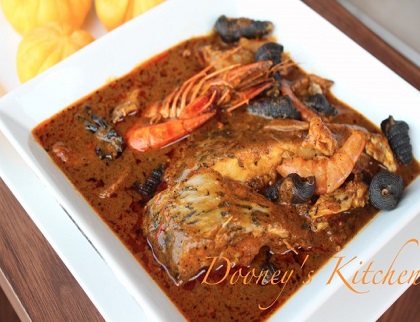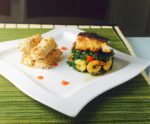Hi Mums! Let’s go cultural. Our recipe of the week is Banga soup. It is native to the Niger Delta and the South Eastern parts of Nigeria. Traditionally Banga soup is made with fresh ingredients in several varieties. Fresh, smoked, shellfish etc. Yes, you can make it with meat, but it truly is not the same. The flavour of fish is so tender and delicate, matching the delicate taste of the palm fruit. If you will use Meat, Bushmeat is best.
This recipe was gotten from the food master herself – Dunni Obata (aka Dooney’s kitchen). Dunni is a food enthusiast with the most amazing recipe. See the recipe for Banga soup below.

[Recipe of the week – Edikaikong: ]
Ingredients
- Palm fruit or Palm nut extract
- Ata rodo – scotch bonnet/habanero pepper
- Oburunbebe stick
- Dried bitter leaves
- Dry red shrimps
- Fresh shrimps
- Periwnkles
- Tilapia– any fresh fish will do
- Powdered Banga spices – Rogojie, Tyko, Obunrubebe stick – some I know by name. There are lots more blended into the spice powder
- Stockfish or smoked fish
Method
1. You need the palm fruit extract. Now, you can do this one of two ways. From scratch which involves boiling the palm fruits, till they soften, and then pounding in a mortar, to extract the juice. After which you add hot water, squeeze the chaff to extract more liquid and then discard. Or you can simply cheat and buy the extract in a can.
2. If you are using the canned version, it comes quite thick, so you need to dilute it with hot water, to make it more fluid, and more like the consistency you would achieve if you were making it from scratch. Dooney’s Kitchen tip: you need it to be fluid, but not so fluid it becomes translucent
3. Then you add the smoked fish varieties, and let them boil till they soften, and you can taste their flavour in the palm fruit extract. I used stockfish and dry red prawns. Notice, that I did not use crayfish. I don’t use crayfish when I cook with fresh fish or shellfish. Its flavour, though amazing is way too strong, it dominates the flavour profile.
4. Add fresh pepper. As much as you can tolerate. Also let this boil. Ata rodo, particularly has its own flavour. Many of us don’t realise that it does. In soups like Banga, you notice that flavour.
5. Add the banga spices in tablespoonfuls until you get the intensity that you want. I used 3 tablespoonfuls for this deep saucepan. Dooney’s Kitchen Tip: i started with 2, and then proceeded to adding one more, to get a kick. Mind you, you really don’t want to use too much or it will taste bitter. Don’t just pour in the spices at once. Start with one or two tablespoons and work your way from there. I also added the oburunbebe stick for added flavour. This is something I observed my grandma do. Just the way the Efik people would add the Uyaya pod. If you don’t have the obunrunbebe stick, that’s fine. It has been blended with the powdery banga spices, so you are covered.
6. Stir and let it boil, till you can smell and also taste the spices in the palm fruit extract.
7. At this point, add the seasoning cubes and salt. Season to the point you will not need to anymore, because once the fish and shelled fish go in, it is not advisable to re-season again.
8. One thing you will notice is that after the banga spices go in, the palm fruit extract thickens. This always happens. If it doesn’t in a few minutes, it means you added too much hot water from the start. One signature thing with the spices is also that they introduces black spots into the soup. This is the signature of those spices, just as using vanilla pod add black spots to whatever it is added to. See the black spots in the picture below.

[Recipe: How to make Ofada rice and sauce]
9. Once it has thickened a bit, then you add the fresh fish, the fresh prawns and periwinkles still in their shell.
10. Immediately they go in, lower the heat and cover the pot. Dooney’s Kitchen tip: it is essential that you lower the heat, because high heat destroys the flavour of fresh fish and seafood, especially when you are cooking them in a large broth. If you’ve always been cooking your fish on high heat, try my method and taste the difference.
11. Once the fish has cooked, the last ingredient to be added is dried bitter leaf. The Urhobos use the Obeletientien leaf, but other parts of Delta use dried bitter leaf. My grandma definitely did. Blend the dried leaves in a mill till it becomes powdery.
12. Sprinkle the powder into the soup. Roughly about a tablespoon or slightly more. You just want a slightly bitter twinge, so don’t over load it.
13. Still with the heat on low, simply let the soup cook until oil starts to float to the surface. This is essential.
14. Once this happens, your Banga Soup is done, and ready to be served. How beautiful does that look.
15. As for the Oburunbebe stick, it still has enough flavour in it for 2 or 3 more soups. So, don’t throw it away. Rinse it off and freeze. It is better to freeze than leaving it in your spice cupboard, to prevent it from growing mould.
16. Dish your Banga soup and serve hot.
